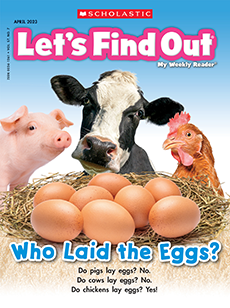A guide for using our resources
Children will explore the phenomenon of a total solar eclipse.
Vocabulary: confused, partial solar eclipse, total solar eclipse
Science Focus: objects in the sky
Simple, spectacular ideas to boost your lessons.
Paired Text: Someone Is Eating the Sun by Ruth Sonneborn
Paired Text: Someone Is Eating the Sun by Ruth Sonneborn
- This story is a sort of cousin to “Chicken Little.” When a solar eclipse begins on the farm, Hen thinks the sun is being eaten! She rushes off to warn the other animals. Will they find out what is really happening?
Science: Light and Shadow
Science: Light and Shadow
- Help kids understand what happens during an eclipse using a flashlight as the sun and a round object such as a frisbee or a paper plate as the moon. Dim the classroom lights and shine a flashlight on the wall. Do kids see the “sun’s” light on the wall?
- Then have a volunteer pass the circular object in front of the flashlight to block the sun’s “rays.” What happens to the light? The “moon” creates a shadow that blocks it. T hat's what happens during a solar eclipse!
Scavenger Hunt: Pages 2-3
Scavenger Hunt: Pages 2-3
- Use pages 2-3 of the issue to do this scavenger hunt as a group.
1. Find the heading. Underline it.
2. Find the picture where kids are wearing safety glasses. Put a ✔ on it.
3. In the pink box, find the word that means the same as “mixed up.” Circle it.
4. Look at the blue box. Put a square around the caption
Hands-on Activity: Paper Plate Eclipse
Hands-on Activity: Paper Plate Eclipse
Skill: art, science knowledge
Materials: paper plates; yellow paint; black paint; large craft sticks; glue, tape, or stapler
- Work together to make sun and moon “puppets.” Paint the backs of two paper plates yellow, and the backs of two paper plates black. Let dry.
- Attach the yellow plates together with the painted sides facing out, placing a large craft stick in between to make a handle. Then do the same with the black plates.
- Let kids take turns using the puppets to act out what happens during a solar eclipse. They can show how the moon slowly passes in front of the sun.
